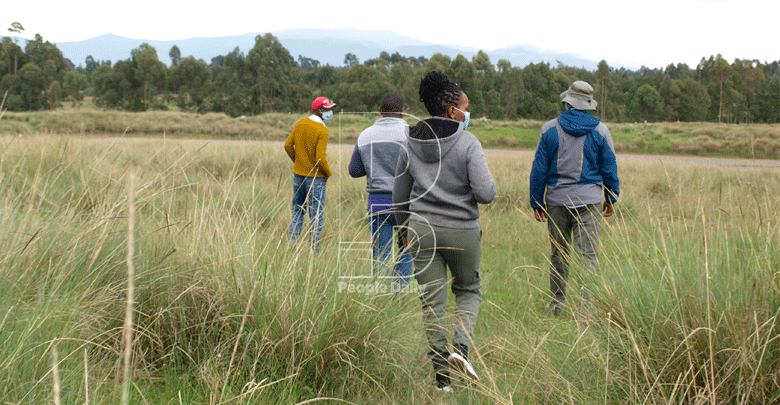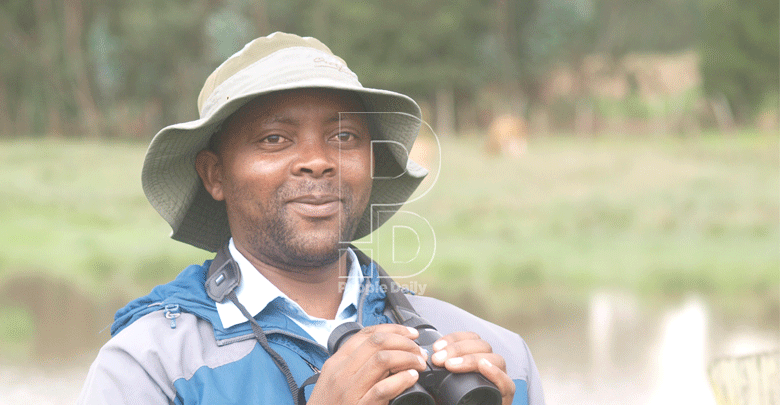Adventurous search for elusive Sharpe’s longclaw

Joseph Maina @MwangiMaina8
Like a needle in a haystack, the Sharpe’s longclaw is an elusive pursuit. It’s a reclusive, timid bird that prefers to mind its own business in the expansive plains of Kinangop, ducking in the long tufts of tussock grass whenever it senses unsolicited attention.
My guide, ornithologist Dominic Kimani, primed me for the possibility of a futile search right from the start of our expedition to sight this bird.
Our journey started off at Murungaru shopping centre, a hamlet along the Naivasha-Ndunyu Njeru road in Nyandarua county.
We left for Kwa Nyoni, a 42-acre conservancy managed by the Friends of Kinangop, a community-based organisation that champions for the preservation of the bird.
As you drive into the conservancy, the first sight is two cone-roofed buildings set against the drape of the undulant Aberdare Ranges in the background. One of the buildings serves as a resource centre.
Cattle from the neighbourhood graze unflustered on the verdant land. A cool breeze sweeps occasionally, gently lashing the tussocks, and mingling with the choirs of birds in the vast grasslands.

Armed with our cameras, binoculars and raging anticipation of fun, we set off. We lumber through the tangle of tussocks, at places tall and thick enough to fully immerse us, as Kimani unleashes his titanic gamut of facts about birds.
Endangered
“Sharpe’s longclaw is an endangered species, and the main threat is the destruction of its habitat,” Kimani says.
“This bird resides in the tussock grasslands. It feeds here. Research has shown that this bird is on the brink of extinction, as it doesn’t build its nest in the trees and only lives in the grasses, on which humans have encroached.”
Informed by these facts, the Friends of Kinangop purchased the land as part of efforts to preserve the bird’s habitat.
Kimani said this particular land could comfortably sustain up to ten pairs of the speicies.
“We have three more pieces of land like this one, purposely to preserve birds — particularly the Sharpe’s longclaw,” Kimani says.
He further informs us that Kenya boasts of 1,100 species of birds, which is 12 per cent of the global list of bird species.
We bump onto a quaint, colonial mansion with iron-sheet roofing, with hints of rust. Kimani says it was put up in 1941 for a colonial officer, and now serves as a museum. The iron sheets date back to this date, but are almost as good as new.
Behind the mansion are cottages, built by the Friends of Kinangop for visitors to the conservancy.
We plunge into the jumble of tussocks once more, emerging at two adjoining water reservoirs, which form another spectacular view of the conservancy’s array of birdlife.
The air is rich with mowing of cattle, bleating of sheep, chirping of crickets and singing of all manner of birds from red-knobbed coots to the yellow-billed egret, the Speke’s weaver, sacred ibis, grey heron, grey-crowned crane, the yellow-billed stork, black stork, hammer cops and Rufous-naped lark, among others.
Parts of the upper water reservoir have a carpet of lilies, and ducks paddle about the waters.
Taking lead of the search party, Kimani instructs the group of six to spread out the meadows as we search for the Sharpe’s longclaw.
We must walk carefully, keen not to scare the bird; we slog through the meadow in search, occasionally triggering sudden flights of birds from the thick grasses.
The fun wells up and adrenaline surges in the team, even as “sightings” of the Sharpe’s longclaw turn out to be false.
It is a long and arduous trek, and spirits keep waning with each false find. Eventually, after hours of spiritedly combing the tough grasses, we give up.
Top secret search
This is not my lucky day, I resolve as I pack my camera and resign myself to a forlorn trip back home.
But Kimani, and his wife Mary, suggest we travel to another meadow just outside Murungaru shopping centre, where we are likely to spot the bird.
Back in his Landcruiser, Kimani narrates his passion for birds. He is an avid bird watcher and conservationist, tracing the roots of his passion to his days in primary school when he teamed up with eight friends to start the Friends of Kinangop. Today he is a conservation biologist, specialising in bird ecology.
Friends of Kinangop has since grown to include members from several other parts of Nyandarua.
Besides its original youthful founders, the group has brought on board older members of the society, incorporating other activities such as beekeeping, agriculture, kitchen gardening and wool spinning.
Arriving at the second meadow, located right along the highway, we immediately set about searching for the bird.
A few false finds later, someone in the team sights a pair of the bird. Excited, we walk, almost on tiptoe and breath almost held, towards the pair, but the birds take off and flit further into the meadows.
We follow them, this time more carefully, and a similar flight takes place. Only in our third attempt do we win some semblance of the birds’ confidence, because they seem to relax and warily pose as we stare and promptly click some photos away.
It feels like the blissful end to a top-secret search for an elusive fugitive, the culmination of a frenzied search for a needle in the haystack that is the verdant plains of Kinangop.
We are all tired, but extremely happy to crown our search with sightings of the two beauties.
Our wearisome search elaborates the diminishing numbers of the Sharpe’s longclaw, and exemplifies the danger of extinction faced by this beautiful bird as it struggles to retain its habitat against overwhelming human encroachment.
But if not for anything else, an expedition in search of this rare bird in the tranquil grasslands of Kinangop is one of the lesser-known fun activities, and it makes for a thrilling activity for the whole family.








